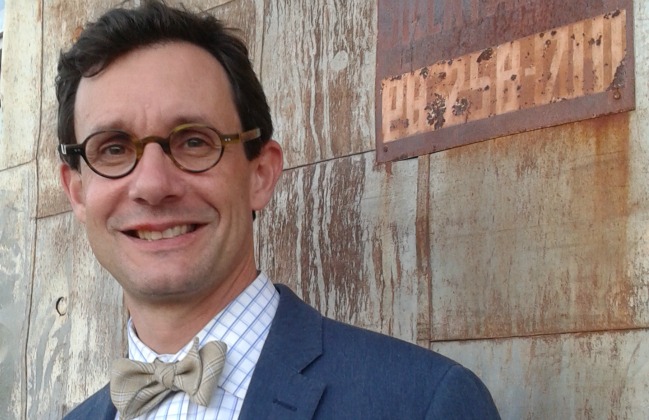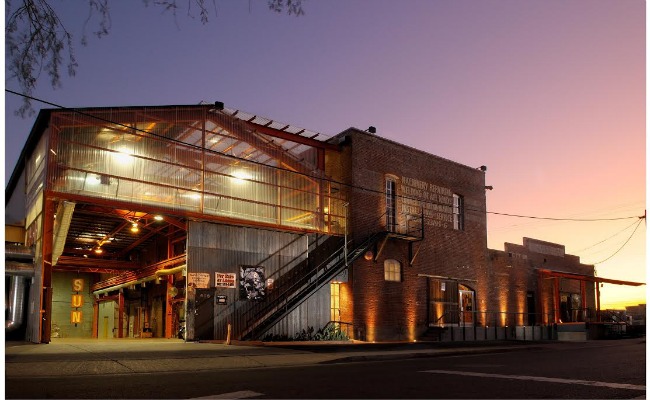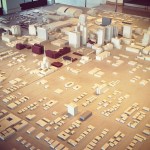In the summer of 2014, Dr. Steven Tepper became the Dean of the ASU Herberger Institute for Design and the Arts, the largest comprehensive design and art school in the nation, which, in alignment with Michael Crow’s vision for the “New American University” had just relocated several of their graduate art programs to a large renovated historic space on Grant Street in the Warehouse District of downtown Phoenix.
As a part of Crow’s vision, departments all across the university have been pulled apart, recombined, reinvigorated, and charged with focusing on the major challenges of our time. While it’s just a small part of the overall Institute, putting the graduate art students in this downtown Warehouse District location has been incredibly successful. “It’s been beyond our wildest imaginings,” said Dean Tepper. “Before this our graduate programs were not in the same place. It’s created a real cohort of young artists inspired by each other’s work across the disciplines, from sculpture and 3-D work to photography, to textiles, to fiber, etc.“
In less than two years, the presence of the students, their studios, visiting faculty and artists, and the adjoining gallery spaces (Step Gallery and Northlight Gallery), along with the increased student and faculty engagement with other downtown arts events, (like Art Detour, and First and Third Fridays) has had a huge impact on the students, and is helping to transform this part of the city.
“We already had highly ranked graduate programs, but this has increased our ability to recruit the top talent and launch careers. More people are coming through the space, more people are seeing the students’ work, and the students are connecting with more people in the community before they graduate. The hope is that they will see Phoenix as a place to stay.”
I asked Dean Tepper what he came hoping to achieve when he arrived a year and a half ago and what surprised him. “I think the idea, broadly, was to ask ‘how do we take the nation’s largest comprehensive design and art school at a research university and use it to reimagine what the arts can be on a campus? In a city? And how does arts education need to change to leverage the impact of what the arts can bring?” He came to ASU knowing that it was an incredible asset and that this is an interesting time in the history of Phoenix and has looked for ways that his experience and expertise could help marshal in a new era.
“I came from a place where I’ve spent my life reading, writing and doing research around the intersection of art and democracy, art and public life….My entire career I’ve had to be an aggressive advocate… and I’ve had to work really hard to make the case that artists and art-based inquiry and design should be part of how we think about solving public policy issues, advancing community. I came here prepared to have to make those arguments.”
But he was surprised and heartened by an unexpectedly welcoming, collaborative environment across the university. “You walk into a partner college, like the College of Public Service & Community Solutions and it turns out that not only does my fellow dean say ‘I get it and I’m so excited to collaborate with you,’ but they’ve already got 20 faculty members who use art in their community development and community service work and that’s true of sustainability, that’s true with journalism, with the nursing, with business.”
After so many years of having to make his case, he has been excited to discover that his colleagues at ASU are enthusiastic about what the arts can offer. “It feels like everyone wants to date us. We’d been at the dance for a long time, sitting over in a metal folding chair by ourselves waiting to be courted and you come here and it’s like, everybody thinks you’re beautiful, everyone thinks you’re the belle of the ball because they recognize the power of a creative collaboration.“ That was a wonderful and unexpected surprise for Tepper. “It’s afforded me the realization that we have to be bigger and bolder in what we’re trying to build here, because there’s a real interest and demand.”
What is next? “We’re excited by the energy that Grant Street brought downtown and we are committed to this design and arts core where 1000 students will eventually be working and living down here, connecting with community partners to use their creativity, talent, imagination, to catalyze, animate and serve the city. “ He doesn’t yet have a lot of details but plans are in the works to start a pilot program next fall that would see 100-150 students engaged with ten partners. “The form has not been determined,” he elaborates, “but, for example, we might connect with a city department, or with a school, or a cultural nonprofit, or with a social service group. We would ask ‘what is a problem or challenge that you are working on? Could a team of 10-12 interdisciplinary students, working with a faculty mentor help contribute to advancing your program or idea, or help solve challenges that you are facing?”
It is all still in the early planning stage, but Tepper is excited about the prospects. “We’re very open to ideas. What we don’t want to do in any way is to presume that we have answers. What we want to do is find trusted partners and spend enough time with them so our students can, in fact, contribute something useful.”
The ASU Herberger Institute for Design and the Arts is in a unique position to take a leadership role nationally in advancing the work of creative place-making and connecting artists to community planning and economic development. “That idea – that artists have a role to play – has been taking root across the country in isolated patches,” says Tepper. “It really should be and can be our country’s next big cultural policy frame, but nobody right now has gathered it together, prioritized it, scaled it, or connected it to training.” And this is where he believes ASU and Herberger can have tremendous impact. “Nobody else can do it, because we’re a global research university and we combine that with an openness…where every faculty-member basically says ‘bring your ideas to me, I’m open to thinking about what a collaboration would look like.’ I don’t think artists at any other research university have this kind of access.”
“The legacy of 20th century was building cathedrals of arts experiences,” he goes on. “You had to leave everyday life and go to this special place. We still believe there are moments for that, because sometimes you have to be in a special place to be transported, but now there is a lot of opportunity to think about art every place, not just art in special places. We have more faculty and students who think that way and feel comfortable working that way than anywhere else.”
Tepper has spent the last year and a half traveling and talking to national foundations and arts leaders in other cities across the country. “I’ve been lifted by how curious and interested people are in what’s happening here,” he says. “The New American University and Michael Crow has such a buzz, and with ASU being ranked the most innovative university in the country, people are excited about investing in this place.”
He has been hearing from people all over the country who’ve spent their lives and careers advancing how the arts impact our life, who are interested in spending more time in Arizona to get in on what’s happening. “It feels like one of those special moments when people are saying ‘how can I be part of this special thing that’s happening?’ and we don’t really even know yet what that special thing will be, but we have a good core set of values and principles.”











To this, I would like to add a HUGE thank you to Director of the School of Art, Adriene Jenik, whose vision, determination, creativity, leadership, and countless(!) hours of work brought Grant Street Studios to the table and through to fruition.
Thank you Kara. Adriene is brilliant and Grant Street was her vision and resulted from her tireless work. Phoenix is lucky to have such an inspired arts leader.
We’re lucky to have you as well, Dr. Tepper! I’m loving what’s happening and what’s to come for HIDA and the SOA.